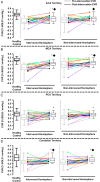Assessing the effect of unilateral cerebral revascularisation on the vascular reactivity of the non-intervened hemisphere: a retrospective observational study
- PMID: 25673438
- PMCID: PMC4325130
- DOI: 10.1136/bmjopen-2014-006014
Assessing the effect of unilateral cerebral revascularisation on the vascular reactivity of the non-intervened hemisphere: a retrospective observational study
Abstract
Objectives: Unilateral haemodynamically significant large-vessel intracranial stenosis may be associated with reduced blood-oxygen-level-dependent (BOLD) cerebrovascular reactivity (CVR), an indicator of autoregulatory reserve. Reduced CVR has been associated with ipsilateral cortical thinning and loss in cognitive function. These effects have been shown to be reversible following revascularisation. Our aim was to study the effects of unilateral revascularisation on CVR in the non-intervened hemisphere in bilateral steno-occlusive or Moyamoya disease.
Study design: A retrospective observational study.
Setting: A routine follow-up assessment of CVR after a revascularisation procedure at a research teaching hospital in Toronto (Journal wants us to generalise).
Participants: Thirteen patients with bilateral Moyamoya disease (age range 18 to 52 years; 3 males), seven patients with steno-occlusive disease (age range 18 to 78 years; six males) and 27 approximately age-matched normal control subjects (age range 19-71 years; 16 males) with no history or findings suggestive of any neurological or systemic disease.
Intervention: Participants underwent BOLD CVR MRI using computerised prospective targeting of CO2, before and after unilateral revascularisation (extracranial-intracranial bypass, carotid endarterectomy or encephaloduroarteriosynangiosis). Pre-revascularisation and post-revascularisation CVR was assessed in each major arterial vascular territory of both hemispheres.
Results: As expected, surgical revascularisation improved grey matter CVR in the middle cerebral artery (MCA) territory of the intervened hemisphere (0.010±0.023 to 0.143±0.010%BOLD/mm Hg, p<0.01). There was also a significant post-revascularisation improvement in grey matter CVR in the MCA territory of the non-intervened hemisphere (0.101±0.025 to 0.165±0.015%BOLD/mm Hg, p<0.01).
Conclusions: Not only does CVR improve in the hemisphere ipsilateral to a flow restoration procedure, but it also improves in the non-intervened hemisphere. This highlights the potential of CVR mapping for staging and evaluating surgical interventions.
Keywords: NEUROPHYSIOLOGY.
Published by the BMJ Publishing Group Limited. For permission to use (where not already granted under a licence) please go to http://group.bmj.com/group/rights-licensing/permissions.
Figures


References
-
- Paulson OB, Strandgaard S, Edvinsson L. Cerebral autoregulation. Cerebrovasc Brain Metab Rev 1990;2:161–92. - PubMed
Publication types
MeSH terms
Substances
LinkOut - more resources
Full Text Sources
Other Literature Sources
Research Materials
